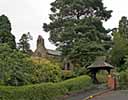 Sutton Bonington Sutton Bonington
St Anne
Churchyard
St. Anne’s churchyard rises steeply to the eastern boundary alongside the Midland Mainline railway cutting. Prior to the building of the railway in 1840 this area of the church would have continued to what is now known as Saint Anne’s Manor.
In 1839 the Midland Railway Company bought from the church 2r (rood) 3p (perch) of Glebe and 1r. 1p of churchyard for £606. In 1849 an exchange was made by the rector with Mr. Paget for 7a. 2r. 22p to add the St. Anne’s Manor Park and in return he received 14a. 2r. 26p at Hungary lane.
 The church and The church and
lychgate from the
south-west |
The traditional approach to St. Anne’s church is from St. Anne’s Lane, entering through the lychgate bearing the inscription 'BLESSED ARE THE DEAD WHICH DIE IN THE LORD' on the west side and on the other side is an inscription to the memory of F. A. Paget, the local land owner who lived in St. Anne’s Manor.
The lychgate was erected in 1885 and restored in 1985 with a major restoration in 2006 due to its deterioration over the previous century. This approach leads up a short steep winding slope to the porch.
A second entrance is now available to the church via Rectory Close and through a gate into the north side of the churchyard, from the recent housing development in the grounds of the old vicarage. It makes visiting the church much easier, having an area for parking cars and a more level approach to the church avoiding the steep slope from St. Anne’s Lane.
The churchyard, roughly square in shape, is situated on a steep incline hence most of the graves are on the lower slope especially the more recent ones, some of the older graves are towards the upper edge of the yard. The older part is more natural and overgrown in the groundwork whilst the lower area which also includes access to the church is more trim and neat. The upper area of the graveyard was cleared of undergrowth in the early 21st century and extended to the north giving added burial area. The church is roughly centrally placed in the yard, slightly offset to the east.
A dedicated burial area for cremated remains is established on the western edge of the churchyard, with a wooden bench alongside to meditate and reflect.
The ground to the west wall of the church has been relieved from the base and stoned to allow the stonework to breathe as other surrounding areas reducing damp. Much undergrowth has accumulated around the north aisle outside, hiding the access to the redundant underground boiler house. A tarmac path was laid to the north gate in 2007 and lamps installed in 2011.
An interesting burial in an unmarked and lost grave is that of William Riste, a village stone mason, who died in 1773. Being a giant of a man he stood 7ft 4½ ins. tall. The Royal Family viewed his body no less than three times and George III presented him with a scarlet silk suit. The grave measured 10ft in length; the coffin, measuring 8ft 4ins by 16ins deep, was secured with iron bars and fixed to prevent his body from being removed for ‘further use’. William, who died of consumption at the age of 33 years had eight men of the village as coffin bearers supported by eight young maidens of the village as pall bearers, and some 500 mourners. It is not confirmed as to him being buried in the chancel or the graveyard.
The boundaries of the churchyard largely comprise low hedges with some mature and semi mature trees and shrubs. On the east side the boundary is a stone wall.
|